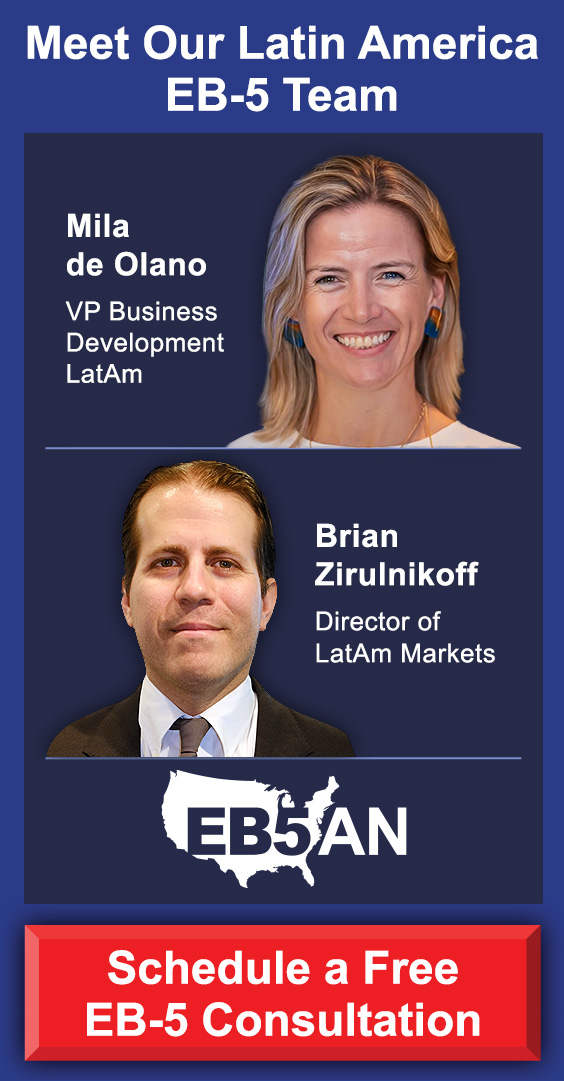If you’re thinking about pursuing an EB-5 visa, you probably have a long list of questions, some you know to ask, and others you haven’t even thought of yet. That’s completely normal. The EB-5 Immigrant Investor Program is a valuable but complex immigration pathway that involves many moving parts: immigration law, investment regulations, job creation rules, and more.
So where should you start?
While you’ll eventually need professionals, i.e., immigration attorneys, financial advisors, and EB-5 regional center teams, it can be incredibly helpful to begin your journey with one of the most accessible tools at your fingertips: artificial intelligence (AI).
AI tools like ChatGPT, Grok or Microsoft Copilot can help demystify the process, organize your early thoughts, and prepare you for more informed conversations down the road.
In this article, we’ll explore how AI can be a helpful starting point and a smart way to reduce confusion and gain clarity at the very beginning of your EB-5 journey.
Understanding the EB-5 Steps
Differences Between Rural vs. Urban Projects
Hiring an Experienced Immigration Attorney
Why AI Is a Smart First Step, but Not the Last
Laying the Groundwork for Success
Understanding the EB-5 Steps
Before you even begin collecting documents or comparing projects, it’s essential to understand the overall shape of the EB-5 process. This is a multi-step journey that includes immigration filings, investment timelines, and meeting job creation goals. AI tools can walk you through each phase in a way that’s personalized, clear, and accessible, even if you’re not a legal expert.
Try asking:
- “Break down the EB-5 immigration steps in order.”
This can give you a simple, digestible overview of the full process, from filing the I-526E petition, to receiving a conditional Green Card, to eventually removing conditions through Form I-829.
- “What documents do I need for source of funds?”
One of the most critical (and often complex) parts of the EB-5 application is proving that your investment funds were lawfully earned. AI can help you understand what’s typically required, like bank records, employment history, tax returns, and how detailed the documentation needs to be.
- “Explain job creation requirements for I-829 approval.”
The final step of the EB-5 process hinges on whether your investment helped create at least 10 qualifying jobs for U.S. workers. AI can explain how jobs are counted, what types qualify, and how this affects your ability to remove the conditions on your Green Card.
By using prompts like these, you can get a general roadmap of the process and better prepare yourself for professional conversations down the line.
Differences Between Rural vs. Urban Projects
One of the first big decisions EB-5 investors face is whether to invest in a rural or urban project. Each has its own benefits, timelines, and visa availability implications. Understanding the differences can help you start shaping your preferences early, before you start comparing individual investment offerings.
AI tools can break down these distinctions in real time, helping you think through your options clearly.
Try these prompts:
- “What are the differences between rural and urban EB-5 projects?”
This will give you a basic comparison, such as how rural projects may offer faster processing times.
- “What are the benefits of rural EB-5 projects compared to urban ones?”
Some investors value shorter waiting times, while others prioritize location, risk profile, or project type. AI can help you explore those trade-offs.
- “Explain EB-5 visa availability for rural vs. urban projects.”
Visa backlogs are a real concern in some countries. While both urban and rural projects are in the reserved visa category, differences in filing demand and petition processing pace can make a significant difference.
- “What factors should I consider before deciding between rural and urban EB-5?”
AI can help you create a personal checklist based on your goals, whether it’s faster immigration, a specific region, or alignment with a long-term relocation plan.
AI doesn’t replace legal or investment advice, but it can help you ask smarter questions and avoid overlooking key factors early on.
Hiring an Experienced Immigration Attorney
No AI tool can or should replace a qualified EB-5 immigration attorney. But AI can help you get more value from your professional consultations. Think of it as a brainstorming assistant—someone to help you shape your questions, organize your priorities, and identify what to look for in a legal partner.
Using AI to Understand What to Ask
Instead of going into a consultation unsure of what matters, you can generate a focused list of key questions.
Try asking:
- “Give me 5 important questions to send to potential EB-5 immigration attorneys before I decide who to retain.”
- “What qualifications should I look for in an EB-5 immigration attorney?”
- “Explain common red flags to watch for when selecting an EB-5 immigration attorney.”
Preparing for Your First Meeting
Good attorneys appreciate when clients come prepared. AI can help you create a checklist of what to bring to your consultation, making the process smoother for both sides.
Sample prompt:
- “What documents should I prepare before my first EB-5 attorney consultation?”
Using AI this way ensures you don’t waste time (or billable hours) on questions that could have been researched beforehand. It also helps you evaluate attorneys more effectively by giving you a baseline understanding of the process and your own needs.
Why AI Is a Smart First Step, but Not the Last
AI can be an excellent starting point for the EB-5 process. It’s fast, private, accessible, and always available. You can explore ideas, clarify confusing terms, and even role-play scenarios to understand different stages of the immigration path.
However, it’s important to treat AI as a launch pad, not the destination. The EB-5 process involves legal nuances, regulatory compliance, and financial risk. You’ll eventually need to consult qualified professionals to guide you through each step. But by using AI first, you’ll be better equipped to ask the right questions, spot important decision points, avoid beginner mistakes, and understand what you don’t yet know. In a process as intricate (and high-stakes) as EB-5, that early clarity can make a real difference.
Laying the Groundwork for Success
Starting your EB-5 journey can feel overwhelming, especially when you’re trying to navigate a foreign immigration system, unfamiliar investment rules, and a long-term process. But it doesn’t have to be a shot in the dark.
AI tools like ChatGPT, Grok or Microsoft Copilot are giving global investors the power to explore, learn, and plan in a new way, on their own terms and at their own pace. Whether you’re mapping out the process, comparing project types, or preparing to meet with an attorney, AI can be your co-pilot at the very beginning of the journey.
And on this journey, you will need experienced and transparent professionals to assist you at every step.
EB5AN has helped more than 2,700 families from 70+ countries become lawful permanent residents of the United States. Our team has more than a decade of experience and offers clients first-rate, low-risk EB-5 regional center projects with a 100% USCIS project approval rate.
If you would like to know more about your EB-5 investment options, book a free call with our expert team today.










